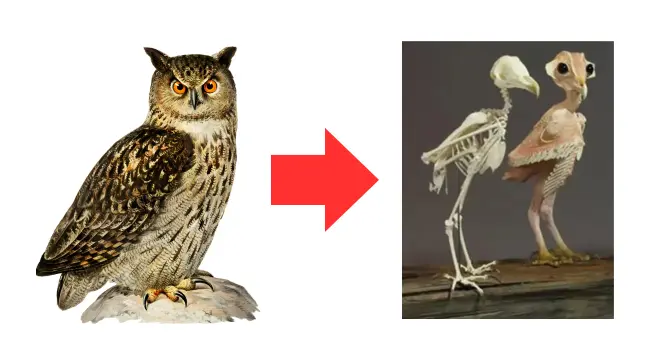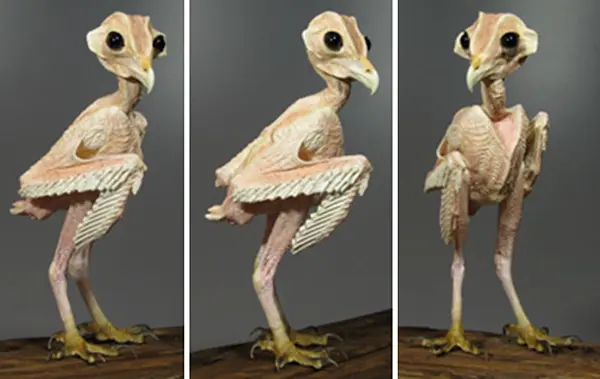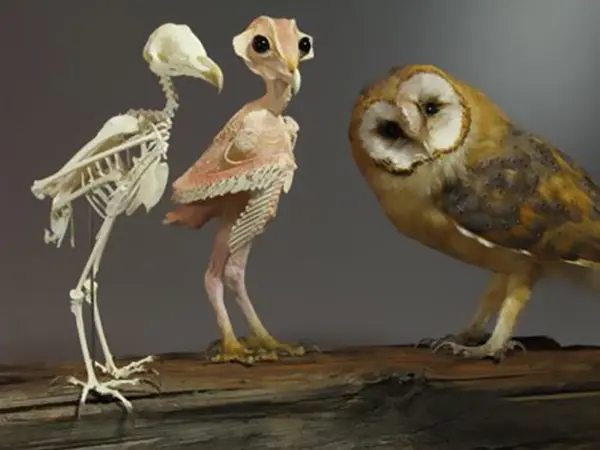
Owls are majestic creatures of the night, known for their enigmatic appearance and silent flight. These birds of prey have long captured the human imagination, but have you ever wondered what an owl without feathers looks like? In this article, we will explore the intriguing world of owls without feathers, shedding light on their unique biology and the reasons behind their featherless appearance.
Featherless Owls: Myth or Reality?
Before we delve into the details of featherless owls, it’s essential to clarify that owls are not naturally featherless. Feathers are vital to their survival, serving multiple functions such as insulation, camouflage, and silent flight. However, there have been some rare and unusual cases where owls have been found without feathers due to specific circumstances.
Dana Schwartz posted an astonishing image of a featherless owl:


Next, she drew a fascinating comparison between the featherless owl, a fully feathered counterpart, and the intricate framework of an owl’s skeleton.


Featherless Owls in Rehabilitation
One of the most common scenarios where featherless owls are encountered is in wildlife rehabilitation centers. Injured or orphaned baby owls may require specialized care and attention, and sometimes, this involves the temporary removal of feathers. Featherless baby owls are a sight to behold, with their pinkish skin and large, expressive eyes. But why would feathers be removed in the first place?
Feather removal in rehabilitation is typically done for medical reasons. It allows veterinarians and wildlife rehabilitators to treat wounds or injuries more effectively and monitor the bird’s health. It’s essential to stress that this is a temporary measure, and as the owl heals and grows, its feathers will gradually regrow, enabling it to return to the wild.
Genetic Mutations and Featherless Owls
In extremely rare cases, genetic mutations can lead to owls being born with a lack of feathers. These mutations can affect the genes responsible for feather development, resulting in owls with bald patches or even entirely featherless bodies. These unique individuals face significant challenges in the wild, as feathers are crucial for their survival. Without proper insulation and camouflage, they become vulnerable to extreme weather conditions and predators.
The Beauty of Feathered Owls
While the idea of featherless owls may pique our curiosity, it’s essential to appreciate the incredible beauty of these birds in their natural, feathered state. Owls are renowned for their soft, velvety plumage, which aids in noiseless flight and provides them with excellent camouflage against tree bark or foliage. Their large, round eyes and distinct facial discs further add to their charm.
In conclusion, while the concept of owls without feathers may be intriguing, it’s important to understand that these magnificent birds are best appreciated in their feathered form. Featherless owls, when encountered, are typically in need of special care and attention to ensure their well-being. The next time you have the privilege of observing an owl, take a moment to admire the intricate beauty of their feathers, which are essential to their survival and a testament to the wonders of nature.
What Does an Owl Without Feathers Look Like?
Owls without feathers indeed present a unique and unusual sight when compared to their feathered counterparts. While these occurrences are exceedingly rare, it’s intriguing to imagine what such an owl might look like if ever encountered.
Exposed Skin: The most striking characteristic of a featherless owl is its exposed skin. Instead of the usual plumage, their bodies reveal naked skin, which can exhibit a range of colors from a delicate pinkish hue to a more subdued grayish tone. This skin often displays a slightly wrinkled texture and may appear somewhat translucent.
Enhanced Facial Features: Without the concealing veil of feathers, the owl’s facial features take center stage. Their beaks, typically partially concealed, would become more pronounced, with a sharp and hooked appearance. The eyes, maintaining their large, round shape and dark pupils, become even more captivating.
Leaner Physique: Feathers contribute to an owl’s robust appearance, and in their absence, the owl’s underlying body structure becomes more evident. This can give the impression of a slimmer, more streamlined physique.
Exposed Claws: Owls rely heavily on their powerful talons for hunting and gripping prey. Without feathers to hide them, these talons are revealed in all their formidable glory, showcasing the owl’s exceptional hunting tools.
A Humbling Glimpse: Observing featherless owls might evoke a sense of vulnerability and humility. Feathers serve critical functions, including insulation, aiding in silent flight, and providing protection from the elements. Consequently, the absence of feathers can make these remarkable birds appear more delicate and less regal than their feathered counterparts.
Types of Featherless Owls
- Eastern Screech Owls (Megascops asio): In the case of featherless Eastern Screech Owls, it’s a rare occurrence. These owls are usually small and elusive, but when featherless, their skin exhibits a pale pink hue. The reasons behind this phenomenon can vary and may include genetic anomalies or environmental factors.
- Snowy Owls (Bubo scandiacus): Featherless snowy owls are an extraordinary sight. These majestic birds, known for their white plumage, may occasionally be found with patches of exposed skin. The reasons behind feather loss in snowy owls can be diverse, including injuries, diseases, or even severe molting.
- Barred Owls (Strix varia): Featherless barred owls are a rare occurrence but have been observed. When devoid of feathers, their skin can appear pale and delicate. The causes of featherlessness in barred owls may range from health issues to genetic anomalies, requiring careful consideration and observation.
- Boreal Owls (Aegolius funereus): Featherless boreal owls are a seldom-seen anomaly. In the absence of feathers, their skin may take on a grayish or pinkish tone. Researchers are still delving into the underlying factors behind featherlessness in these elusive birds, which typically inhabit northern forests.
These paragraphs provide insights into featherless variations of different owl species, showcasing the uniqueness of each case and the factors that may contribute to feather loss in these remarkable birds.
Why Owls Lose Their Feathers
Featherlessness in owls, while rare, can result from various factors, including:
- Genetic Mutations: Genetic anomalies or mutations can disrupt the normal development of feathers in owls. These mutations may affect the genes responsible for feather growth, leading to partial or complete featherlessness.
- Nutritional Deficiencies: In some cases, featherless owls may suffer from nutritional deficiencies, particularly in the early stages of life. Inadequate nutrition can hinder the proper development of feathers, resulting in bald patches or overall featherlessness.
- Injuries: Severe injuries to an owl’s feathers or skin can lead to feather loss. These injuries can be caused by accidents, collisions, or interactions with predators or other animals.
- Disease and Infections: Certain diseases or infections can affect the health of owls, leading to feather loss as a secondary symptom. Feather mites, fungal infections, or other health issues can impact feather quality and growth.
- Molting Issues: Owls go through regular molting cycles where they shed and replace old feathers. Any disruption in the molting process, such as stress, illness, or environmental factors, can result in featherlessness.
- Environmental Stress: Extreme environmental conditions, such as exposure to harsh weather, can damage feathers and lead to feather loss. Owls rely on their feathers for insulation and protection, so exposure to extreme cold or wet conditions can be detrimental.
- Human Interference: In rare cases, human interference, such as capturing owls for illegal trade or keeping them as pets, can lead to feather damage or loss.
- Hormonal Changes: Hormonal imbalances or changes in an owl’s body due to factors like age or reproductive cycles can affect feather growth and condition.
- Parasitic Infestations: Parasites like feather mites or lice can infest an owl’s plumage, leading to feather loss as they damage and consume the feathers.
It’s important to note that featherlessness in owls is not a typical or healthy condition for these birds. When encountered, it often indicates an underlying health issue or environmental stressor. In cases of featherless owls found in the wild, it’s crucial to consult with wildlife experts and rehabilitators to provide appropriate care and support for their recovery.
FAQ
Can hairless owls fly?
No, hairless owls cannot fly. Feathers are crucial for flight, providing lift and insulation. Without them, owls lose their ability to soar and regulate body temperature, making flight impossible.
Which owl cannot fly?
The kakapo, nicknamed the “owl parrot,” is a flightless, nocturnal bird. Though not a true owl, its owl-like face and tree-climbing skills earned the name. It’s the only flightless parrot and native to New Zealand.
Can owls fly yes or no?
Yes, owls can fly. Most owls fly almost silently and slower than other raptors, aiding their nocturnal hunting. Silent flight helps them sneak up on prey alert to nighttime sounds.
What would an owl look like without feathers?
An owl without feathers would look unusual, with long legs, slender bodies, large eye sockets, and prominent beaks. Feathers are crucial for their iconic appearance and flight, so featherless owls appear more skeletal and less recognizable.
Are there birds without feathers?
No, all birds naturally have feathers—essential for flight, insulation, and species identity. Rarely, birds lose feathers due to disease (e.g., avian baldness), but this isn’t natural. Even flightless birds like penguins or ostriches retain feathers for warmth and display.
How rare is it to see a great horned owl?
Great horned owls are common but rarely seen. Their nocturnal habits and superb camouflage in trees make them elusive. Spotting one requires patience and luck, as they blend seamlessly into their surroundings and hunt primarily at night.



